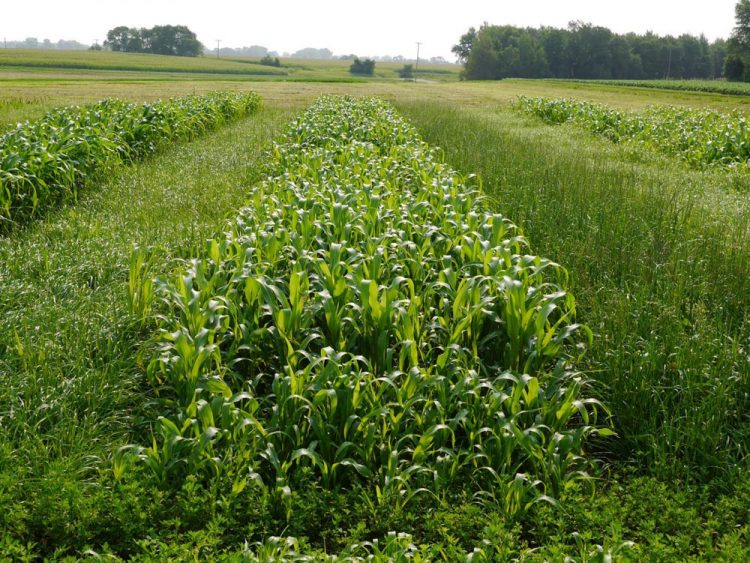Alfalfa loss? Annual ryegrass is a win

This photo shows Italian ryegrass (left), sorghum-Sudangrass (center), and annual ryegrass + red clover (right) in test plots. Credit: Reagan Noland Usage Restrictions: Please use with story only
Meet alfalfa, a perennial legume used mainly as high-quality feed for dairy cattle. Alfalfa is also used as feed for beef cattle, horses, sheep, and goats. It's high in protein (16-20% crude protein). It contains a lot of calcium and other minerals and vitamins. It contributes billions of dollars to the United States economy annually.
But alfalfa faces a cold challenge.
In the U.S., alfalfa is grown mainly in western and northern states. The cold winters and other factors in many of these states can damage alfalfa crops. That can lead to losses for farmers and forage shortages.
Researchers at the University of Minnesota are working to help farmers offset losses caused by alfalfa winterkill. They are trying to identify annual forage crops that can be cultivated in fields with winter-killed or terminated alfalfa.
“Planting annual forage crops into terminated alfalfa is an economically viable strategy in response to alfalfa winterkill,” explains M. Scott Wells. Wells is an extension specialist at the University of Minnesota.
However, net economic returns can vary depending on which forage crop is planted. Different forage crops have different characteristics, including yield, nutritive value, tolerance to frequent cutting, and whether they can take root and grow-that is, be established-efficiently.
Wells and his colleagues identified annual ryegrass as the forage crop with the highest net returns when planted into terminated alfalfa in Minnesota test sites.
Finding forage crops that can help farmers offset losses due to alfalfa winterkill will have widespread benefits. In 2013, 93% of alfalfa growers surveyed in Wisconsin and Minnesota reported alfalfa winterkill or injury. Many reported alfalfa losses that were greater than 60%.
But why not simply re-plant alfalfa into the killed or injured alfalfa stands? Older alfalfa release chemicals that can reduce the productivity of newly-seeded alfalfa, and in some cases kill the new stands. “Even if the alfalfa plants do live, there is a chance the plants will be less productive,” says Wells. “It's best to rotate to silage or a small grain forage crop.”
The researchers grew seven different forage crops on terminated alfalfa. They also tested a mixture of annual ryegrass and red clover. They measured yield, nutritive value, how the crops were affected by nitrogen fertilizer, and economic viability.
The study found that the highest yielding forage crops didn't necessarily have the highest economic returns. For example, teff-a grain-and Sudangrass often had the highest yields. But they also provided lower nutritive values. That lowered their economic returns.
On the other end of the spectrum was annual ryegrass, with high yields and high nutritive value. It also established consistently across study sites and years.
“Our work suggests that annual ryegrass is the most reliable and economically viable option to providing early season forage with alfalfa winterkill,” says Wells.
The researchers also tested whether applying nitrogen fertilizer increased economic returns. In general, it didn't. At study sites, nitrogen from terminated alfalfa was often enough to meet the needs of the forage crops. Applying nitrogen fertilizer usually didn't lead to increases in economic returns.
Wells shares research findings through field days, workshops, and newsletters. “The goal is that our research and education will aid farmers in making changes that improve their economic outlook,” he says.
###
Read more about this research in Agronomy Journal.
Media Contact
All latest news from the category: Agricultural and Forestry Science
Newest articles

A ‘language’ for ML models to predict nanopore properties
A large number of 2D materials like graphene can have nanopores – small holes formed by missing atoms through which foreign substances can pass. The properties of these nanopores dictate many…

Clinically validated, wearable ultrasound patch
… for continuous blood pressure monitoring. A team of researchers at the University of California San Diego has developed a new and improved wearable ultrasound patch for continuous and noninvasive…

A new puzzle piece for string theory research
Dr. Ksenia Fedosova from the Cluster of Excellence Mathematics Münster, along with an international research team, has proven a conjecture in string theory that physicists had proposed regarding certain equations….



